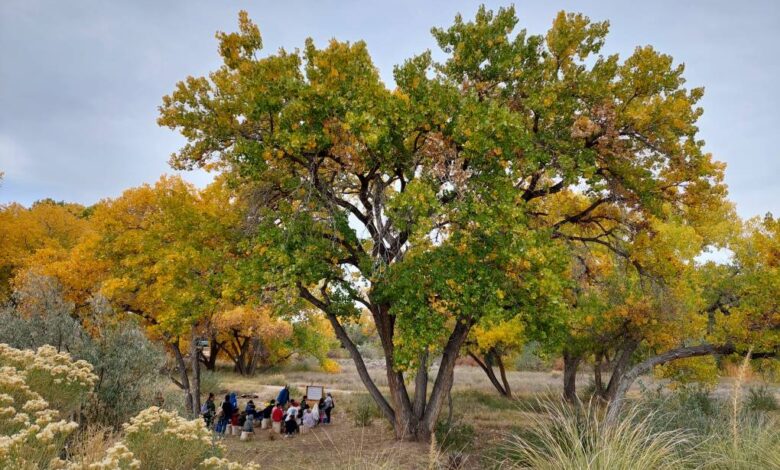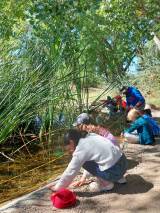How incorporating Indigenous knowledge can deepen outdoor education

And, as recently noted in a review of the potential impact the education sector can have on U.S. cities’ climate plans by This Is Planet Ed (where, full disclosure, I’m a senior advisor), Albuquerque Public Schools is among those pioneering the attempt to connect outdoor learning with local and Indigenous knowledge.
During Los Padillas field trips, the children spend time with Indigenous educators like Jered Lee, whose ancestral roots are in the Naschitti Region of the Navajo reservation in the northwest corner of the state.
“What they learn in the classroom is very important, yes. But what they learn through their own healthy exploration of their senses, that’s also important,” he said. “Even though I don’t live in a dirt floor hogan like our ancestors, their values can still be applied to my livelihood today.”
Perhaps surprisingly, Lee doesn’t much care for the term “climate change”; he finds it too political. “We hear that we live in unprecedented times; well, when was it ever precedented? As far as I have understood, as far as our traditional stories, the world has always been changing,” he said. What he seeks to instill in his brief time with the children is a sense of gratitude for being alive, and connection to other living things.
“They sit on the grass, and I sit on the earth with them, and try to see things from their eyes … I ask them to name their five senses, which they all know, and then I say, ‘Who taught you how to use them?’ And they might say ‘My mom,’ and then they think about it … and it’s almost like they refer to a divine source. They didn’t have to be instructed, and it’s in line with other growth processes in the natural world.”
Lee shares with the children a version of the Navajo creation story, and another one about horses, but he won’t tell them to a reporter on tape: They are part of an oral tradition passed down to him from his elders. He will say that he talks to the children about the rhythms of nature, and humans’ place in the world.

“The movement of nature, the rising of the dawn, the daytime sky, the evening light and the darkness of night, and how that process regenerates itself and the elongation of that process creates the spring, summer, fall, winter, and creates our being, our livelihood … for many it’s like we’re separate from that, we’re above that and we’re more intelligent than that. But the most intelligent people I know adhere to nature and know there isn’t a knowledge that surpasses that. It’s a humbling realization for people but it’s also good.”
Some 80% of the students enrolled in Albuquerque Public Schools are people of color. Around 5.3% are American Indian and are served by the district’s Indian Education Department.
Monie Corona works within that department in a newly created position, supporting Los Padillas and other outdoor programming. Her watchwords are “cultural humility, cultural relevance and the cultural landscape.” She said this collaboration, bringing Indigenous learning to all students in an outdoor setting, “has been a long time coming, let’s put it that way. As a [white] teacher coming in 30 years ago, I was not prepared for working with Native American students and their culture. There’s a lot of things we have to understand and be able to respect as well.”
She said her focus and that of her colleagues sharpened in 2018, after a state court’s decision in Yazzie/Martinez v. State of New Mexico found that the state wasn’t doing enough to meet its obligation to help all students become college and career ready, especially low-income students, Native Americans, English language learners and students with disabilities. New Mexico’s high school graduation rate is consistently among the lowest in the nation; Albuquerque’s is even lower, at 69% in 2022.
Corona hopes that the Los Padillas program, as well as aligned efforts to bring Indigenous traditions into the school garden program and into outdoor learning opportunities at all grade levels, will enhance student engagement, particularly for those with Native heritage.
“Making sure the kids know their culture — it’s not easy,” she said. “We want to build up their self esteem, their motivation to be at school.”
Lee said that just about every time he speaks to a class, one or two children will raise their hand and say, “I’m Navajo, too!” or name another tribe. But his aim is to share his culture and language and find commonalities with students, no matter their background. “Here in Albuquerque there’s different cultures. And I’ve realized this about many cultures around the world, the more you talk to them, our language, our customs may be different but the root of our cultural values are very similar.”
Source link



